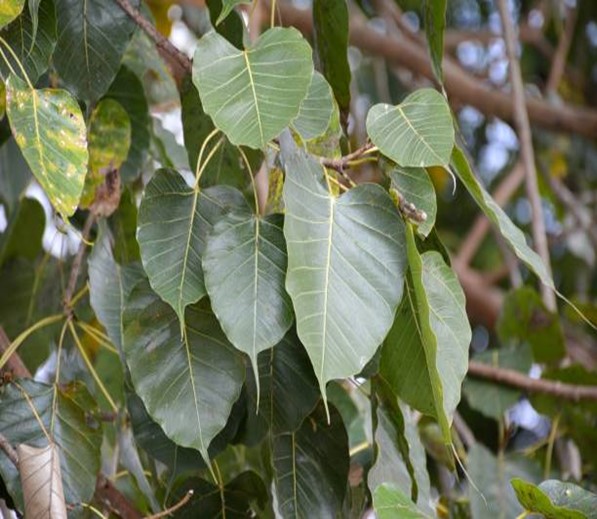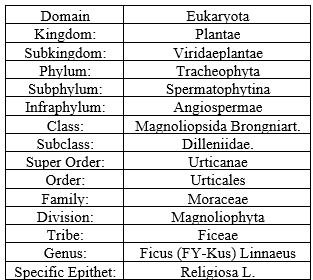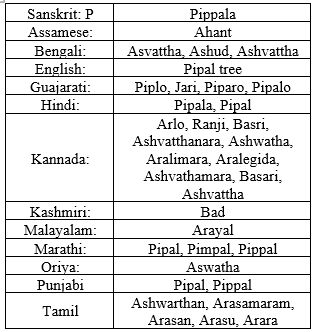Abstract
The cough is most common problem are faced by all people. There are two types of cough dry cough and wet cough. The aim of this study to develop and optimize herbal cough syrup utilizing Ficus Religious commonly known as peepal tree, through decoction method . Ficus Religious has been traditionally recognized for its medicinal properties, particularly in managing cough symptoms. Among respiratory complications, cough is an important defensive pulmonary relflex that removes fluids, irritants or foreign substances from the respiratory tract. The chemical analysis showed that Ficus Religious contained tannins, phenols, saponins, sugars, alkaloids, terpenoids, flavonoids, glycosides, proteins, separated amino acid. Previous Pharmcological studies revealed that ficus religiosa possessed antimicrobial, anti-parasitic , anti-parkinsons, anticonvulsant, anti-amnesic, anticholinergic, antidiabetic, analgesic, cytotoxic, anti-cancer, wound healing antioxidant, Drugs currently used to treat cough are among the most widely used over-the-counter drugs in the world, despite a recent analysis suggesting that there us a little evidence to such drugs produce any meaningful efficacy.
Keywords
Herbal cough syrup, Dry cough, wet cough, decoction extraction, Anticonvulsant Activity .
Introduction
Herbal plants and formulations are used for many types of disease like cough and other respiratory diseases. Various herbal plants like pudina, adulsa, Tulsi, cinnamon and turmeric are used in the cough syrup. Herbal formulation a most commonly used for development as well as developing countries as health care. The cough syrup medication is a liquid dosage form used as oral liquid pharmaceutical has been confirm on basic ease of administration to those people who have the problem in the swallowing of solid dosage from medication. Syrup is a concentrated solution contains sugar and purified water. The syrup may be or may not be containing medication or mixed flavoring agent. When the syrup without a medication but the flavoring agent present are known as flavored or non medicated syrup[1]. There is an increasing interest in use of plants in health care for its claimed safety and benefits. Clinical relevance and evidence have been the basis of phytomedicine developments in the past. Standardization, quality control and methods for validation of single or multiple claims of medicinal plants or their derivatives, are newer challenges that we now face in order to provide scientific bases to them[2]. Medicinal plants have played a significant role in maintaining human health and improving the quality of human life for thousands of years and have served humans as valuable components of medicines, seasonings, beverages, cosmetics and dyes. Numerous plants synthesize substances that are useful in the maintenance of health in humans and animals[3].
Advantages of herbal syrup:
- No side effects
- No Harmless
- Easily available
- Easy to adjust the dose for child’s weight
- No nursing is required, which main and the patient can take it with no help.
- The liquid dosage form is executed for products like cough medicines.
- Herbs Grow in common place.
- Antioxidant by retarding the oxidation as sugar is Hydrolyzed in to cellulose and dextrose
- Good patient compliance especially pediatric patients as syrup are sweet in test
- It is a preservative by retarding the growth of bacteria, fungi and mould as osmotic pressure
Disadvantage Of Herbal Cough Syrup
- Sedimentation of solid occasionally gives foot from of product
- Dose precision cannot be achieved unless suspension suspensions are packed in unit dosage forms.
- Same microbial contamination take place it preservation not added in accurate proportion
- Also herbal medicine having another disadvantage is the risk of self dosing of herbs which is very rare.
- Fluctuation in storage temperature may cause crystallization of sucrose from saturated syrup.(29,30)
VEDIC HISTORY OF FICUS RELIGIOSA
With over 150 names, Ficus religiosa, also referred to as peepal, is the most well-known member of the Ficus genus. In Indian culture, Ficus religiosa has mythical, religious, and therapeutic significance. Numerous ancient sacred scriptures, including the Arthasastra, Puranas, Upanishads, Ramayana, Mahabharata, Bhagavadgita, and Buddhist literature, mention Ficus religiosa[6]. The fig tree variety Ficus religiosa was already referred to as the bodhi tree before Gautama Buddha meditated under its branches and attained enlightenment. It is possible to refer to this as the fabled "World Tree" or the "Tree of Life" of the Indian subcontinent because it is the oldest tree ever shown in Indian literature and art. The people that revere this plant are It was given the moniker "Sacred Fig" because adherents of Buddhism, Jainism, and Hinduism view it as sacred[8]. Large deciduous trees are called sacred figs or peepal trees. It is frequently planted close to religious sites and temples. Presumably one of the longest-living trees, there is an allegedly over a millennium-old specimen in Sri Lanka. The roots of this tree develop very quickly and are joined to the trunk as though it were 5005 International Journal of Pharmaceutical and Chemical Sciences Vol. 4, (3), July–September 2015, ISSN: 2277, www.ijpcsonline.com 361 They serve as its pillars. The soil must be sufficiently deep to allow the tree's roots to spread out, and it requires a lot of room. It He declares in the Bhagavad Gita, "Among trees, I am the ashvattha." It is said that Krishna passed away beneath this tree, marking the start of the current Kali Yuga. In India, the five trees (Panchavat) are revered. These three are: 1. Fig tree, 2. A wild fig tree (Gular sycamore), 3. Banyan tree 4. Indian fig tree; 5. Mango tree; 5. Pakar (citron-leaved). The Skanda Purana states that a peepal shall be considered a son if a person does not have one. The tree will live on, and so will the family name. Cutting down a peepal tree is regarded as one of the five deadly sins, or Panchapataka, equal to the murder of a Brahmin. The Skanda Purana states that a person goes to hell.
TAXONOMY / BOTANICAL CLASSIFICATION


VERNACULAR NAMES(11)

PHYTOCHEMICAL CONSTITUENTS
Preliminary phytochemical screening of F. religiosa barks, showed the presence tannins, saponins, flavonoids, steroids, terpenoids and cardiac glycosides.(12,13)
Constituents of the bark
Phytosterols like, lanosterol, ?-sitosteryl D-glucoside, bergapten, bergaptol and stigmasterol have been isolated from the petroleum ether and alcoholic extracts of the bark of F. religiosa (18,19,20) The bark of F. religiosa comprises around 8.7% of total tannin content.(21) Phenolic components, acid detergent fiber (ADF), neutral detergent fiber (NDF), acid detergent lignin (ADL) and saponins have been identified in the inner bark of F. religiosa.(22) The bark also contains tannin, wax, saponin, leucocyanidin-3-0-?-D-glucopyrancoside, leucopelargonidin- 3-0-?-Dglucopyranoside, leucopelargonidin-3-0-?-L-rhamnopyranoside, lupeol, ceryl behenate, lupeol acetate, ?-amyrin acetate, leucoanthocyanidin and leucoanthocyanin.(14)
Constituents of the fruits
Asparagine and tyrosine are the most abundant amino acids of the fruit pulp of F.religiosa.(26) F. religiosa fruits contain a considerable amount of flavonoids namely kaempeferol, quercetin, and myricetin and other phenolic components.(15)
Constituents of the leaves
Leaves yield campestrol, stigmasterol, isofucosterol, ?-amyrin, lupeol, tannic acid, arginine, serine, aspartic acid, glycine, threonine, alanine, proline, tryptophan, tryosine, methionine, valine, isoleucine, leucine, nnonacosane, n-hentricontanen, hexa-cosanol and n-octacosan.(16,17)
Constituents of the seeds
The seeds contain phytosterolin, ?-sitosterol, and its glycoside, albuminoids, carbohydrate, fatty matter, coloring matter, caoutchoue 0.7– 5.1%(23-24). Important structures of active constituents present in F. religiosa given below. prostaglandins. Thus suggest that extract showed the analgesic effect probably by inhibiting synthesis or action of prostaglandins(25)
PHARMACOLOGICAL ACTIVITIES:
- Anticonvulsant activity
- Antiulcer activity
- Anti-inflammatory activity
- Anti-asthmatic activity
- Antimicrobial activity
- Anti-anthelmintic activity
- Anti-anxiety activity
- Anticancer activity
- Anti-diabetic activity
METHOD OF PREPARATION
Preparation of herbal cough syrup by decoction method:
The initial stage in studying medicinal plant is the preparation of plant samples to preserve the biomolecules in the plants prior to extraction. Plants samples such as leaves, barks, roots, fruit sand flowers can be extracted from fresh or dried plant materials such as grinding and drying also influences the preservation of phytochemicals in the final extracts The weighed crude drug sample 5g of herbal ingredients. Then herbal ingredients mix with 500 ml of water. Then attach reflux condenser and materials boil carefully by using water bath for 3 hrs. The mixture boil until total volume become one fourth of the volume. Then the decoction cool and filter. Take a filtrate to prepare final syrup.(27,28)
EVALUATION PARAMETERS[31,32,33]
Colour Examination:-
- 5ml of prepared syrup was taken on a watch glass.
- Watch glass placed against white background in white tube light.
- Colour was observed by naked eyes.
Odour Examination
- 2ml of prepared syrup was taken and smelled by individually.
- The time interval between 2 smelling was 2 min to nullify effect of previous smelling.
Taste Examination :
- A pinch of final syrup was taken and examined on taste buds of the tounge.
pH Determination:
- 10ml of prepared syrup taken in 100ml of volumetric flask.
- Make up volume to 100ml with distilled water.
- Sonicate for 10 min.
- pH was measured by using digital pH meter.
Viscosity Determination:
- The viscosity of each formulation was determined by using Ostwalds U-tube Viscometer
Stability Testing:
Stability Testing of the prepared herbal syrup was performed on keeping the sample at accelerated temperature conditions. Nine portions of the final herbal syrup A,B and C were taken kept at accelerated temperature at 4c .Room temperature and 47 c respectively. The sample were tested for all the physicochemical parameters , turbidity and homogeneity at the interval of 24hr 48hr and 72 hr to observe any change.
FUTURE SCOPE
The herbs are used around the world to treat conditions and diseases and many studies prove their efficacy. Herbal syrups are quite positive as there is increasing interest in natural and herbal remedies for respiratory illness. Herbal syrups are perfect way to preserve herbs for consumption over time , while also offering properties that are soothing for the throat
CONCLUSION
Among respiratory track disorders cold and cough are common symptoms having variety of reasons behind them. It can lead to the serious disease if not treated in time. Proper diagnoses can cure this problem by different types of medicinal drugs commonly found around us alone or in combination. The Pre-formulation studies of all formulations were within specifications. Also the physiochemical properties of prepared syrup like colour, odour, pH, taste were satisfactory but among the all three formulation is was within the all specification, it has proper concentration of honey as per IP and also a good preservative. The present study help to develop affective and safe herbal cough syrup with 40% W/V honey as a base of cough syrup.
REFERENCES
- C.G.BUTLER.C.O. Jefferand H. Kalmsted Experimental S and D.B.V college Received 4Jully1943.
- Bhatt NS, ‘Phytomedicine–An Ayurvedic Perspective for Future’ In the 43rd Annual Meeting of the American Society of Pharmacognosy and 3rd Monroe Wall Symposium New Brunswick NJ July 27-31, 2002; Program and Abstracts S8: 67.
- Sawarkar HA, Singh MK, Pandey AK and Biswas D. In vitro anthelmintic activity ofFicus bengalhensis, Ficus caria & Ficusreligiosa: a comparative anthelmintic activity. International J PharmTech Research. 2011;3:152-153.
- Whittaker RH and Margulis L. Prolist classification and kingdoms of organisms.
- Biosystems. 1978;10(1-2):3-18.
- Kala CP. Prioritization of medicinal plantson the basis of available knowledge;
- Existing practices and use value status inUttaranchal. Ethnobotany and Biodiversity
- Conservation. 2004;12:453-459.
- Prasad PV, Subhakttha PK, Narayan A and Rao MM. Medico-histotical study of “asvattha”(sacred fig tree). Bulletin of the Indian Institute of History of Medicine (Hyderabad). 2006;36:1-20.
- Chauhan DS and Merh SS. Evolutionary history of a lost river of north western India.Banglore: Vedic Saraswati; Geological Society of India. 1999:35-44.
- Yadav YC, Srivastava DN, Saini V and Sighal S. Experimental Studies of Ficus religiosa(L) latex for preventive and curative effect against cisplatin induced nephrotoxicity in wistar rats. J Chem Arm Res. 2011;3(1):621-627.
- Warrier PK, Nambiar VPK and Ramankutty C. Indian Medicinal Plants. Vol.1-5. Madras: Orient Longman Ltd.; 1995:418.
- Shastri NK, Chaturvedi and Charak Samhita. 6th edition. Vol.1. Varanasi: Chaukhambha Bharati Academy; 1978:5
- Shailja Singh and Shalini Jaiswal. Therapeutic Properties of Ficus Regligiosa. International Journal of Engineering Research and General Science. 2014;2(5):2091-2730.
- Babu K, Shankar SG and Rai S. Comparative pharmacognostic studies on the barks of four Ficus species. Turk J Bot. 2010;34:215-224
- . Jiwala SA, Bagul MS, Parabia M and Rajani M. Evaluation of free radical scavenging activity of an ayurvedic formulation. Indian J Pharm Sci. 2008;70:31-35
- . Husain A, Virmani OP, Popli SP, Misra LN, Gupta, MM, Srivastava, GN, Abraham Z and Singh AK. Dictionary of Indian Medicinal Plants, CIMAP, Lucknow, India. 1992:546.
- Mali S and Borges RM. Phenolics, fibre, alkaloids, saponins, and cyanogenic glycosides in a seasonal cloud forest in India. Biochemical Systematics and Ecology. 2003;31:1221–1246.
- Panda SK, Panda NC and Sahue BK. Effect of tree leaf tannin on dry matter intake by goats. Indian Vet J. 1976;60:660- 664
- . Suryawanshi K, Khakre S, Chourasia A, Chaurasiya PK, Pawar RS and Jhade D. Hepato-protective activity of stem bark extract of Ficus Religiosa Linn in Rat. International Journal of Biomedical Research. 2011;8:466- 475
- Ambika SH and Rao MRR. Studies on a phytosteroin from the bark of Ficus religiosa. Indian Journal of Pharmacy. 1967;29:91–94
- Swami KD and Bisht NPS. Constituents of Ficus religiosa and Ficus infectoria and their biological activity. Journal of the Indian Chemical Society. 1996;73:631
- Swami KD, Malik GS and Bisht NPS. Chemical investigation of stem bark of Ficus religiosa and Prosopis spicigera. Journal of the Indian Chemical Society. 1989;66:288–289
- Osima Y and Ito H. Vegetable tannins in Formosa III. Nippon Nogeikagaku Kaishi. 1939;15:634–635
- Mali S and Borges RM. Phenolics, fibre, alkaloids, saponins, and cyanogenic glycosides in a seasonal cloud forest in India. Biochemical Systematics and Ecology. 2003;31:1221–1246
- Panda SK, Panda NC and Sahue BK. Effect of tree leaf tannin on dry matter intake by goats. Indian Vet J. 1976;60:660- 664.
- . Suryawanshi K, Khakre S, Chourasia A, Chaurasiya PK, Pawar RS and Jhade D. Hepato-protective activity of stem bark extract of Ficus Religiosa Linn in Rat. International Journal of Biomedical Research. 2011;8:466- 475.
- Sreelekshmi R, Latha PG, Arafat MM, Shyamal S, Shine VJ, Anuja GI, Suja SR and Rajasekharan S. Natural product radiance. 2007;6:377-381.
- Ali M and Qadry JS. Amino acid composition of fruits and seeds of medicinal plants. Journal of the Indian Chemical Society. 1987;64:230– 231.
- Azwanida NN,” A Review on the Extraction Methods Use in Medicinal Plants, Principle, Strength and Limitation”, Azwanida, Med Aromat Plants 2015, 4:3.
- Handa SS, Khanuja SPS, Longo G, Rakesh DD (2008) Extraction Technologies for Medicinal and Aromatic Plants, (1stedn), no. 66. Italy: United Nations Industrial Development Organization and the International Centre for Science and High Technology.
- . A.V. Sharma and p.v Sharmaflavouring agent in pharmaceutical formulations a overview article Ancient science of life.
- Eizbieta Hazar and Alicjawodinika a determination of ethanol content in medicated syrup by static headspace Gas Chromatography Received by 2013
- Anukaushik Vivek, Chauhan and Dr. Sudha, Formulation and Evaluation of Herbal Cough Syrup. European Journal of Pharmaceutical & medical Research, 2016; 3(5): 517522.
- Swain Pramod Kumar, Nayak Durga Prasan,” Design, Development & Evaluation of a Poly Herbal Syrup from some herbs used as Energy booster”, International Journal of Ayurvedic Medicine, 2013; 4(4): 374-378.
- Akula Nikhil Prashant, Dr. K. V. Subramanyam, Dr.ManoranjanSahu P. Sai Karthik, T. Madhavi, G. Mounika and FasihaTamkanat, “development and evaluation of herbal cough syrup from the root extracts of withaniasomnifera and glycyrrhizaglabra”, world journal of pharmacy and pharmaceutical sciences, 14 Sept. 2017, DOI:10.20959/wjpps201710-10104


 Damkondwar Santosh T.*
Damkondwar Santosh T.*
 Dahale Ankita A .
Dahale Ankita A .
 Lokhande Prerana M.
Lokhande Prerana M.



 10.5281/zenodo.10913689
10.5281/zenodo.10913689